Thermo-Environmental Assessment of a Heated Venlo-Type Greenhouse in the Yangtze River Delta Region
Abstract
:1. Introduction
2. Methodology
2.1. Modeling and Numerical Simulation
2.1.1. Governing Equations
2.1.2. Turbulence Model
2.1.3. Radiation Model
2.1.4. Crop-Zone Sub-Model
2.2. Numerical Model and Mesh Generation
2.2.1. Mesh Generation
2.2.2. Numerical Model
- Boundary and Initial Conditions
- 2.
- Numerical method
2.3. Experimental Setup and Measurements
2.3.1. Experimental Setup
2.3.2. Experimental Data Collection
2.4. Model Validation
3. Results
3.1. Model Validation
3.2. Airflow Analysis
3.3. Thermal Assessment
3.4. Humidity Analysis
4. Discussion
5. Conclusions
Author Contributions
Funding
Acknowledgments
Conflicts of Interest
Nomenclature
| spectral absorption coefficient of the participating medium (m−1) | |
| absolute humidity inside the greenhouse (kg kg−1) | |
| viscous resistance (m−2) | |
| inertial resistance (m−1) | |
| coefficient of drag | |
| specific heat of air at atmospheric pressure (J kg−1 K−1) | |
| acceleration due to gravity (m s−2) | |
| h | height of the canopy (m) |
| characteristic height of the greenhouse (m) | |
| heat transfer coefficient (W m−2 K−1) | |
| spectral intensity of the radiation (W m−2) | |
| thermal conductivity (W. m−1. K−1) | |
| extinction coefficient of radiation (-) | |
| l | characteristic length of the leaf (m) |
| leaf–air sensible heat exchange (W m−2) | |
| leaf–air latent heat exchange due to leaf transpiration (W m−2) | |
| position vector (m) | |
| aerodynamic resistance (s m−1) | |
| stomatal resistance (s m−1) | |
| coefficient of determination (-) | |
| Ra | Rayleigh number (-) |
| global solar radiation (W m−2) | |
| net radiation on the leaf (W m−2) | |
| greenhouse inside air humidity () | |
| directional vector (-) | |
| scattered vector with direction of the ray originating from direction (-) | |
| source term of the variable, ∅ (-) | |
| volumetric leaf area density (m2 m−3) | |
| leaf area index (m2 m−2) | |
| t | time (s) |
| greenhouse inside air temperature (K or ) | |
| temperature of the leaf (K or ) | |
| greenhouse outside air temperature (K or ) | |
| sky temperature (K or ) | |
| velocity magnitude (m s−1) | |
| uj | velocity component in the direction (m s−1) |
| external wind speed (m s−1) | |
| vapor pressure deficit (Pa) | |
| coordinate in the direction of the cartesian space (m) | |
| arbitrary height within the crop canopy (m) | |
| Greek Symbols | |
| thermal diffusivity (m2s−1) | |
| thermal expansion coefficient (K−1) | |
| slope of the saturated water vapor pressure curve according to temperature (Pa K−1) | |
| psychometric constant (Pa K−1) | |
| diffusion coefficient of the variable, ∅ (-) | |
| average angle between the leaf and the horizontal plane () | |
| radiation wavelength (m) | |
| kinematic viscosity (kg m−1 s−1) | |
| density (kg. m−3) | |
| spectral scattering coefficient of the participating medium (m−1) | |
| transport variable (-) | |
| scattering phase function (-) | |
| solid angle of radiation (-) | |
| Abbreviations | |
| AH | absolute humidity |
| CFD | computational fluid dynamics |
| CO | carbon monoxide |
| CO2 | carbon dioxide |
| SO2 | sulfur dioxide |
| NO | nitrogen oxide |
| DO | discrete ordinates |
| DOM | discrete ordinates model |
| MAE | mean absolute error |
| RTE | radiative transfer equation |
| RMSE | root mean square error |
| FCU | fan coil unit |
References
- Odhiambo, M.; Wang, X.; de Antonio, P.; Shi, Y.; Zhao, B. Effects of Root-Zone Temperature on Growth, Chlorophyll Fluorescence Characteristics and Chlorophyll Content of Greenhouse Pepper Plants Grown under Cold Stress in Southern China. Russ. Agric. Sci. 2018, 44, 426–433. [Google Scholar] [CrossRef]
- Peng, B.; Wang, Y.; Elahi, E.; Wei, G. Behavioral game and simulation analysis of extended producer responsibility system’s implementation under environmental regulations. Environ. Sci. Pollut. Res. 2019, 26, 17644–17654. [Google Scholar] [CrossRef] [PubMed]
- Elahi, E.; Weijun, C.; Jha, S.K.; Zhang, H. Estimation of realistic renewable and non-renewable energy use targets for livestock production systems utilising an artificial neural network method: A step towards livestock sustainability. Energy 2019, 183, 191–204. [Google Scholar] [CrossRef]
- Riad, P.; Graefe, S.; Hussein, H.; Buerkert, A. Landscape transformation processes in two large and two small cities in Egypt and Jordan over the last five decades using remote sensing data. Landsc. Urban Plan. 2020, 197, 103766. [Google Scholar] [CrossRef]
- Benli, H. Energetic performance analysis of a ground-source heat pump system with latent heat storage for a greenhouse heating. Energy Convers. Manag. 2011, 52, 581–589. [Google Scholar] [CrossRef]
- Kumar, K.V.; Bai, R.K. Solar greenhouse assisted biogas plant in hilly region–A field study. Sol. Energy 2008, 82, 911–917. [Google Scholar] [CrossRef]
- Esen, M.; Yuksel, T. Experimental evaluation of using various renewable energy sources for heating a greenhouse. Energy Build. 2013, 65, 340–351. [Google Scholar] [CrossRef]
- Ghoulem, M.; El Moueddeb, K.; Nehdi, E.; Boukhanouf, R.; Calautit, J.K. Greenhouse design and cooling technologies for sustainable food cultivation in hot climates: Review of current practice and future status. Biosyst. Eng. 2019, 183, 121–150. [Google Scholar] [CrossRef]
- Kuroyanagi, T. Investigating air leakage and wind pressure coefficients of single-span plastic greenhouses using computational fluid dynamics. Biosyst. Eng. 2017, 163, 15–27. [Google Scholar] [CrossRef]
- Boulard, T.; Roy, J.-C.; Pouillard, J.-B.; Fatnassi, H.; Grisey, A. Modelling of micrometeorology, canopy transpiration and photosynthesis in a closed greenhouse using computational fluid dynamics. Biosyst. Eng. 2017, 158, 110–133. [Google Scholar] [CrossRef]
- Ali, H.B.; Bournet, P.-E.; Cannavo, P.; Chantoiseau, E. Using CFD to improve the irrigation strategy for growing ornamental plants inside a greenhouse. Biosyst. Eng. 2019, 186, 130–145. [Google Scholar]
- Bartzanas, T.; Tchamitchian, M.; Kittas, C. Influence of the heating method on greenhouse microclimate and energy consumption. Biosyst. Eng. 2005, 91, 487–499. [Google Scholar] [CrossRef]
- Teitel, M.; Barak, M.; Antler, A. Effect of cyclic heating and a thermal screen on the nocturnal heat loss and microclimate of a greenhouse. Biosyst. Eng. 2009, 102, 162–170. [Google Scholar] [CrossRef]
- Tadj, N.; Bartzanas, T.; Fidaros, D.; Draoui, B.; Kittas, C. Influence of heating system on greenhouse microclimate distribution. Trans. ASABE 2010, 53, 225–238. [Google Scholar] [CrossRef]
- Couto, N.; Rouboa, A.; Monteiro, E.; Viera, J. Computational fluid dynamics analysis of greenhouses with artificial heat tube. World J. Mech. 2012, 2, 181–187. [Google Scholar] [CrossRef] [Green Version]
- Flores-Velázquez, J.; Villarreal-Guerrero, F.; Rojano-Aguilar, A.; Schdmith, U. CFD to analyze energy exchange by convection in a closed greenhouse with a pipe heating system. Acta Univ. 2019, 29, e2112. [Google Scholar] [CrossRef]
- Zeroual, S.; Bougoul, S.; Benmoussa, H. Effect of Radiative Heat Transfer and Boundary Conditions on the Airflow and Temperature Distribution Inside a Heated Tunnel Greenhouse. J. Appl. Mech. Tech. Phys. 2018, 59, 1008–1014. [Google Scholar] [CrossRef]
- Nebbali, R.; Roy, J.; Boulard, T. Dynamic simulation of the distributed radiative and convective climate within a cropped greenhouse. Renew. Energy 2012, 43, 111–129. [Google Scholar] [CrossRef]
- Villagrán, E.A.; Romero, E.J.B.; Bojacá, C.R. Transient CFD analysis of the natural ventilation of three types of greenhouses used for agricultural production in a tropical mountain climate. Biosyst. Eng. 2019, 188, 288–304. [Google Scholar] [CrossRef]
- Tong, G.; Christopher, D.; Li, B. Numerical modelling of temperature variations in a Chinese solar greenhouse. Comput. Electron. Agric. 2009, 68, 129–139. [Google Scholar] [CrossRef]
- Fidaros, D.; Baxevanou, C.; Bartzanas, T.; Kittas, C. Numerical simulation of thermal behavior of a ventilated arc greenhouse during a solar day. Renew. Energy 2010, 35, 1380–1386. [Google Scholar] [CrossRef]
- Lam, C.; Bremhorst, K. A modified form of the k-ε model for predicting wall turbulence. J. Fluids Eng. 1981, 103, 456–460. [Google Scholar] [CrossRef]
- Patel, V.C.; Rodi, W.; Scheuerer, G. Turbulence models for near-wall and low Reynolds number flows—A review. AIAA J. 1985, 23, 1308–1319. [Google Scholar] [CrossRef]
- Hoff, S.J.; Janni, K.A.; Jacobson, L.D. Three-dimensional buoyant turbulent flows in a scaled model, slot-ventilated, livestock confinement facility. Trans. ASAE 1992, 35, 671–686. [Google Scholar] [CrossRef]
- Chen, Q. Prediction of buoyant, turbulent Flow by a low-renolds-number k-ε model. ASHRAE Trans. 1990, 96, 564–573. [Google Scholar]
- Modest, M.F.; Haworth, D.C. Radiative Heat Transfer in Turbulent Combustion Systems: Theory and Applications; Springer: Berlin/Heidelberg, Germany, 2016. [Google Scholar]
- Versteeg, H.; Malalasekera, W. Computational fluid dynamics. In The Finite Volume Method; Longman Scientific & Technical, Longman Group Limited: London, UK, 1995. [Google Scholar]
- ANSYS_Inc. ANSYS Fluent 2020 R1 Theory Guide; ANSYS_Inc.: Canonsburg, PA, USA, 2020. [Google Scholar]
- Haxaire, R. Caractérisation et Modélisation des écoulements d’air Dans une Serre. Ph.D. Thesis, Université de Nice Sophia Antipolis, Nice, France, 1999; pp. 1–148. [Google Scholar]
- Sase, S.; Kacira, M.; Boulard, T.; Okushima, L. Wind tunnel measurement of aerodynamic properties of a tomato canopy. Trans. ASABE 2012, 55, 1921–1927. [Google Scholar] [CrossRef]
- Wilson, J.D. Numerical studies of flow through a windbreak. J. Wind Eng. Ind. Aerodyn. 1985, 21, 119–154. [Google Scholar] [CrossRef]
- Ali, H.B.; Bournet, P.-E.; Cannavo, P.; Chantoiseau, E. Development of a CFD crop submodel for simulating microclimate and transpiration of ornamental plants grown in a greenhouse under water restriction. J. Comput. Electron. Agric. 2018, 149, 26–40. [Google Scholar]
- Stanghellini, C. Transpiration of Greenhouse Crops. An Aid to Climate Management. Ph.D. Thesis, Wageningen Agricultural University, Wageningen, The Netherlands, 1987. [Google Scholar]
- Villarreal-Guerrero, F.; Kacira, M.; Fitz-Rodríguez, E.; Kubota, C.; Giacomelli, G.A.; Linker, R.; Arbel, A. Comparison of three evapotranspiration models for a greenhouse cooling strategy with natural ventilation and variable high pressure fogging. Sci. Hortic. 2012, 134, 210–221. [Google Scholar] [CrossRef]
- Duffie, J.A.; Beckman, W.A. Solar Engineering of Thermal Processes, 4th ed.; John Wiley & Sons: Hoboken, NJ, USA, 2013. [Google Scholar]
- Dhiman, M.; Sethi, V.; Singh, B.; Sharma, A. CFD analysis of greenhouse heating using flue gas and hot water heat sink pipe networks. Comput. Electron. Agric. 2019, 163, 104853. [Google Scholar] [CrossRef]
- Duffie, J.A.; Beckman, W.A. Solar Engineering of Thermal Processes, 2nd ed.; John Wiley & Sons: Hoboken, NJ, USA, 1991. [Google Scholar]
- López, A.; Valera, D.L.; Molina-Aiz, F.; Peña, A. Thermography and sonic anemometry to analyze air heaters in mediterranean greenhouses. Sensors 2012, 12, 13852–13870. [Google Scholar] [CrossRef] [PubMed] [Green Version]
- Elahi, E.; Abid, M.; Zhang, H.; Cui, W.; Hasson, S.U. Domestic water buffaloes: Access to surface water, disease prevalence and associated economic losses. Prev. Vet. Med. 2018, 154, 102–112. [Google Scholar] [CrossRef] [PubMed]
- Piscia, D.; Montero, J.I.; Baeza, E.; Bailey, B.J. A CFD greenhouse night-time condensation model. Biosyst. Eng. 2012, 111, 141–154. [Google Scholar] [CrossRef]
- Semple, L.; Carriveau, R.; Ting, D.S.K. Assessing heating and cooling demands of closed greenhouse systems in a cold climate. Int. J. Energy Res. 2017, 41, 1903–1913. [Google Scholar] [CrossRef]
- López, J.; Pérez, J.; Montero, J.; Antón, A. Air Infiltration Rate of Almeria “Parral¿ Type” Greenhouse. In Proceedings of the V International Symposium on Protected Cultivation in Mild Winter Climates: Current Trends for Suistainable Technologies 559, Cartagena-Almería, Spain, 7–11 March 2020; pp. 229–232. [Google Scholar]
- Feijó-Muñoz, J.; González-Lezcano, R.A.; Poza-Casado, I.; Padilla-Marcos, M.Á.; Meiss, A. Airtightness of residential buildings in the Continental area of Spain. Build. Environ. 2019, 148, 299–308. [Google Scholar] [CrossRef]
- Sauser, B.J.; Giacomelli, D.G.A.; Janes, D.H.W. Modeling the Effects of Air Temperature Perturbations for Control of Tomato Plant Development. Acta Hortic. 1998, 456, 87–92. [Google Scholar] [CrossRef]
- Baille, A.; López, J.; Bonachela, S.; González-Real, M.; Montero, J. Night energy balance in a heated low-cost plastic greenhouse. Agric. For. Meteorol. 2006, 137, 107–118. [Google Scholar] [CrossRef]
- Kittas, C.; Katsoulas, N.; Baille, A. Influence of an aluminized thermal screen on greenhouse microclimate and canopy energy balance. Trans. ASAE 2003, 46, 1653. [Google Scholar] [CrossRef]
- Montoya, A.; Guzmán, J.L.; Rodríguez, F.; Sánchez-Molina, J.A. A hybrid-controlled approach for maintaining nocturnal greenhouse temperature: Simulation study. Comput. Electron. Agric. 2016, 123, 116–124. [Google Scholar] [CrossRef]
- Vanthoor, B.; Stanghellini, C.; Van Henten, E.J.; De Visser, P. A methodology for model-based greenhouse design: Part 1, a greenhouse climate model for a broad range of designs and climates. Biosyst. Eng. 2011, 110, 363–377. [Google Scholar] [CrossRef]
- Baptista, F. Modelling the Climate in Unheated Tomato Greenhouses and Predicting Botrytis Cinerea Infection. Ph.D. Thesis, University of Évora, Évora, Portugal, 2007. [Google Scholar]
- Li, K.; Xue, W.; Mao, H.; Chen, X.; Jiang, H.; Tan, G. Optimizing the 3D Distributed Climate inside Greenhouses Using Multi-Objective Optimization Algorithms and Computer Fluid Dynamics. Energies 2019, 12, 2873. [Google Scholar] [CrossRef] [Green Version]
- Bournet, P.; Khaoua, S.O.; Boulard, T. Numerical prediction of the effect of vent arrangements on the ventilation and energy transfer in a multi-span glasshouse using a bi-band radiation model. Biosyst. Eng. 2007, 98, 224–234. [Google Scholar] [CrossRef]
- Bournet, P.-E.; Boulard, T. Effect of ventilator configuration on the distributed climate of greenhouses: A review of experimental and CFD studies. Comput. Electron. Agric. 2010, 74, 195–217. [Google Scholar] [CrossRef]
- ASAE. Heating, Ventilating and Cooling Greenhouses; American Society of Agricultural Engineers (ASAE): St. Joseph, MI, USA, 2008. [Google Scholar]
- Abbas, A.; Minli, Y.; Elahi, E.; Yousaf, K.; Ahmad, R.; Iqbal, T. Quantification of mechanization index and its impact on crop productivity and socioeconomic factors. Int. Agric. Eng. J. 2017, 26, 49–54. [Google Scholar]
- Elahi, E.; Khalid, Z.; Weijun, C.; Zhang, H. The public policy of agricultural land allotment to agrarians and its impact on crop productivity in Punjab province of Pakistan. Land Use Policy 2020, 90, 104324. [Google Scholar] [CrossRef]
- Teitel, M.; Segal, I.; Shklyar, A.; Barak, M. A comparison between pipe and air heating methods for greenhouses. J. Agric. Eng. Res. 1999, 72, 259–273. [Google Scholar] [CrossRef]
- Bournet, P.-E. Assessing greenhouse climate using CFD: A focus on air humidity issues. In Proceedings of the International Symposium on New Technologies for Environment Control, Energy-Saving and Crop Production in Greenhouse and Plant 1037, Jeju, Korea, 6–11 October 2013; pp. 971–985. [Google Scholar]
- Piscia, D.; Muñoz, P.; Panadès, C.; Montero, J. A method of coupling CFD and energy balance simulations to study humidity control in unheated greenhouses. Comput. Electron. Agric. 2015, 115, 129–141. [Google Scholar] [CrossRef]
- Vadiee, A.; Martin, V. Energy management in horticultural applications through the closed greenhouse concept, state of the art. Renew. Sustain. Energy Rev. 2012, 16, 5087–5100. [Google Scholar] [CrossRef]
- Elahi, E.; Weijun, C.; Zhang, H.; Nazeer, M. Agricultural intensification and damages to human health in relation to agrochemicals: Application of artificial intelligence. Land Use Policy 2019, 83, 461–474. [Google Scholar] [CrossRef]
- Elahi, E.; Weijun, C.; Zhang, H.; Abid, M. Use of artificial neural networks to rescue agrochemical-based health hazards: A resource optimisation method for cleaner crop production. J. Clean. Prod. 2019, 238, 117900. [Google Scholar] [CrossRef]
- Rabbi, B.; Chen, Z.-H.; Sethuvenkatraman, S. Protected cropping in warm climates: A review of humidity control and cooling methods. Energies 2019, 12, 2737. [Google Scholar] [CrossRef] [Green Version]
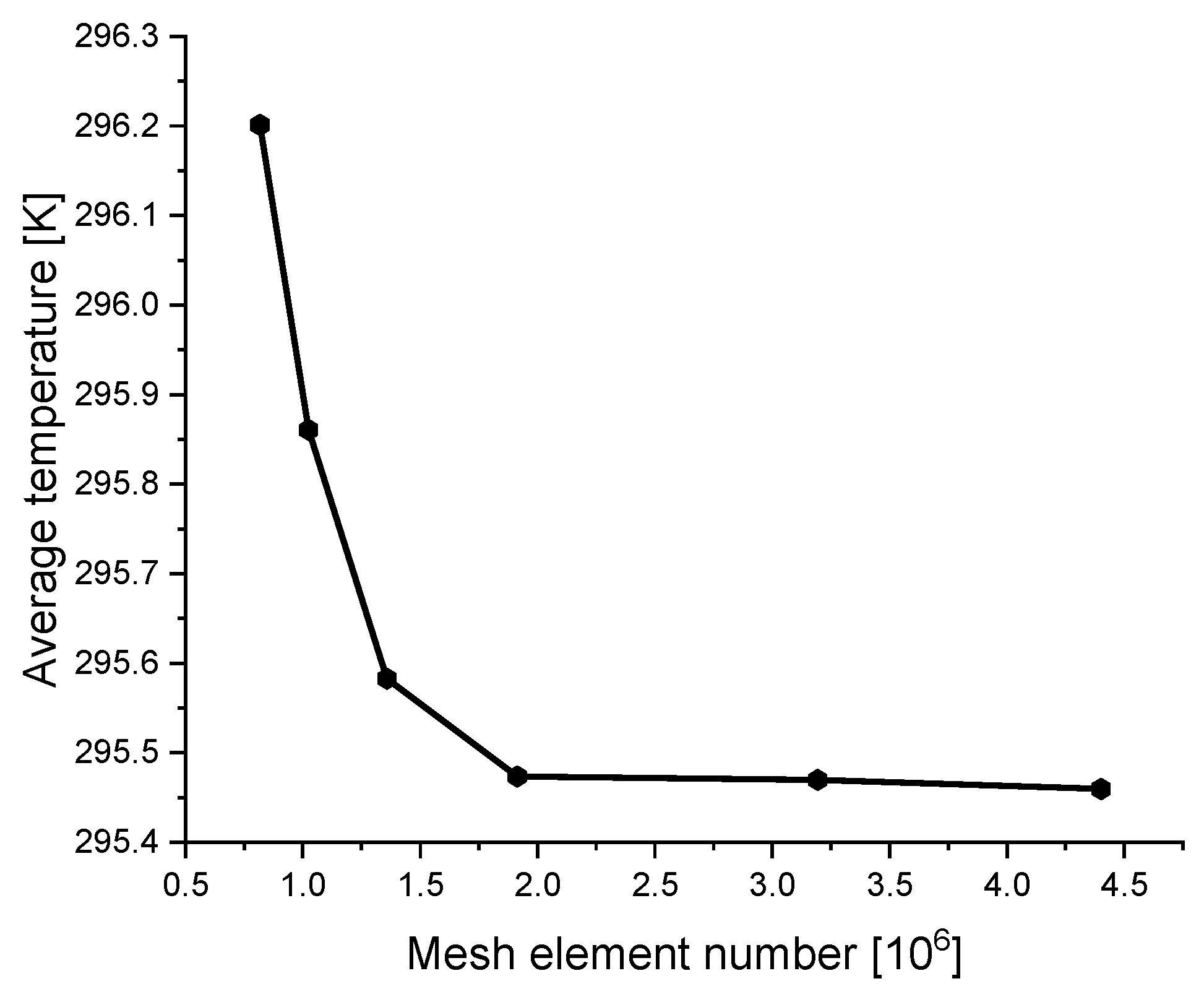
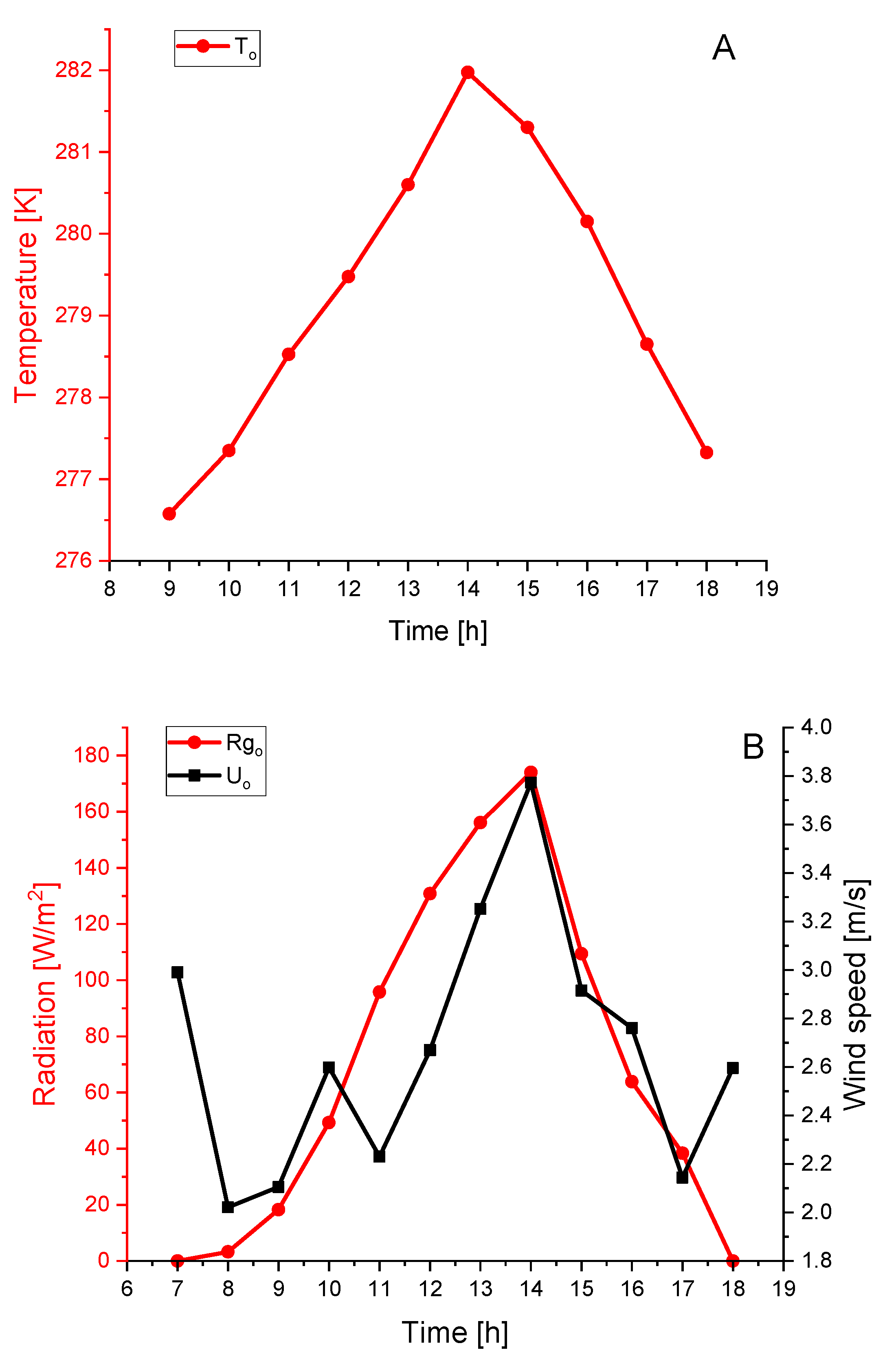
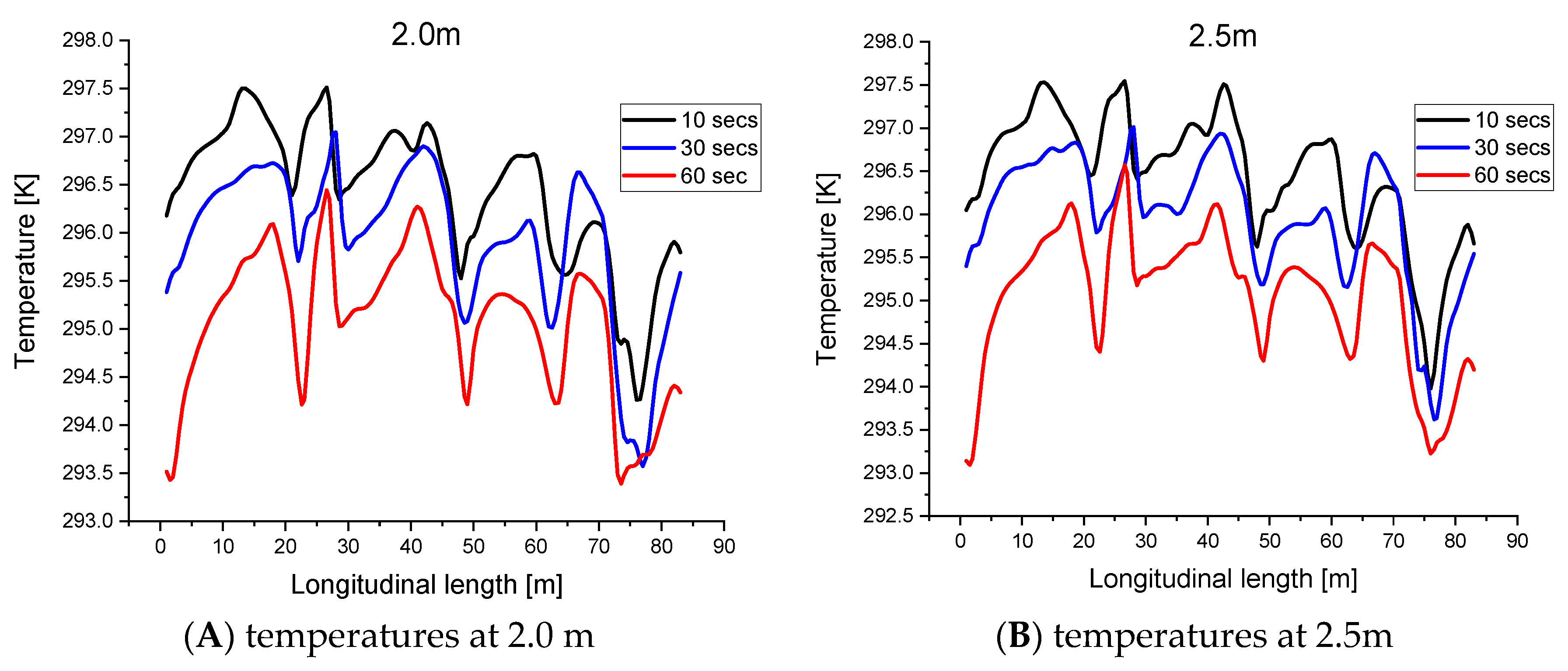
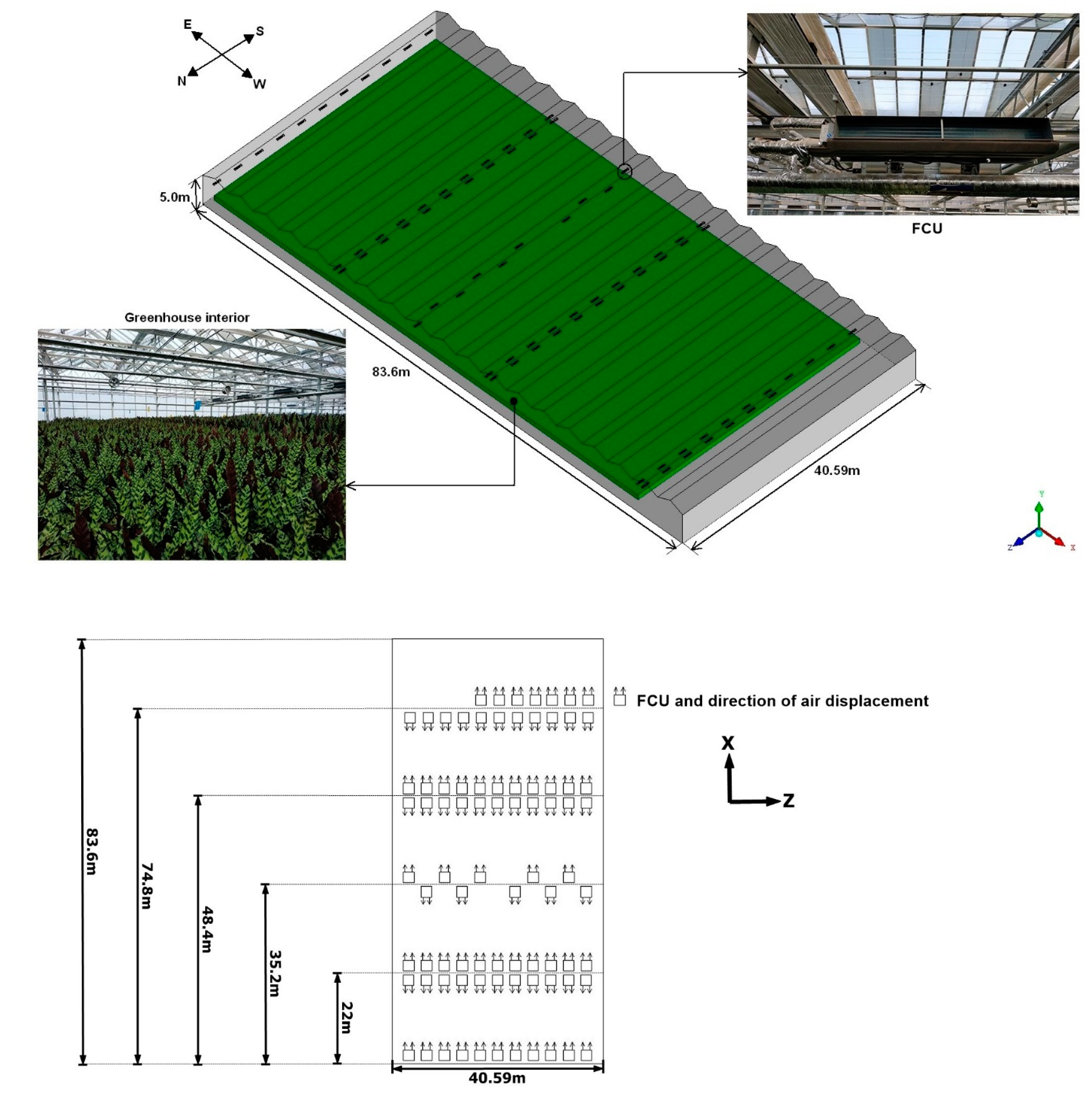
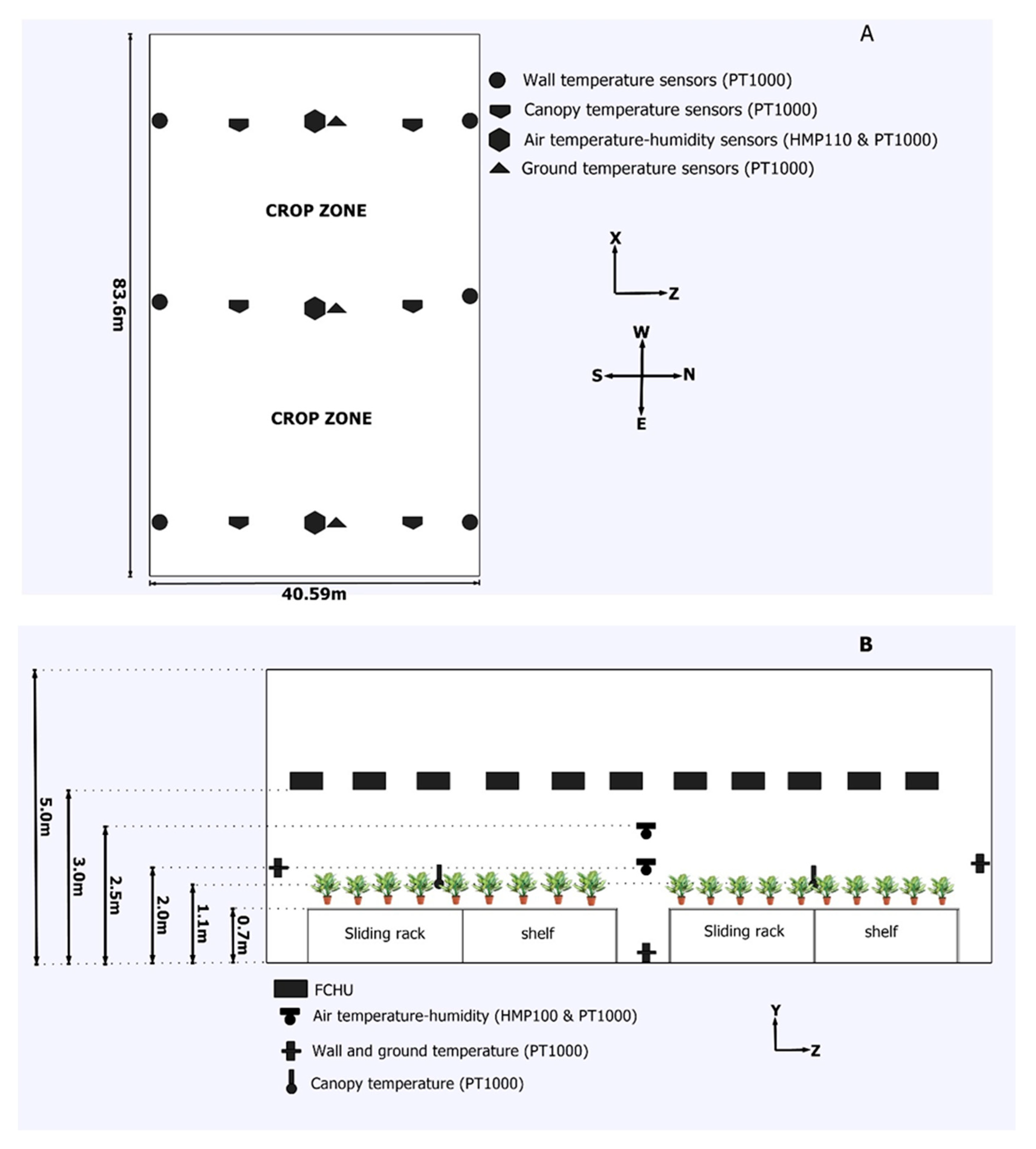
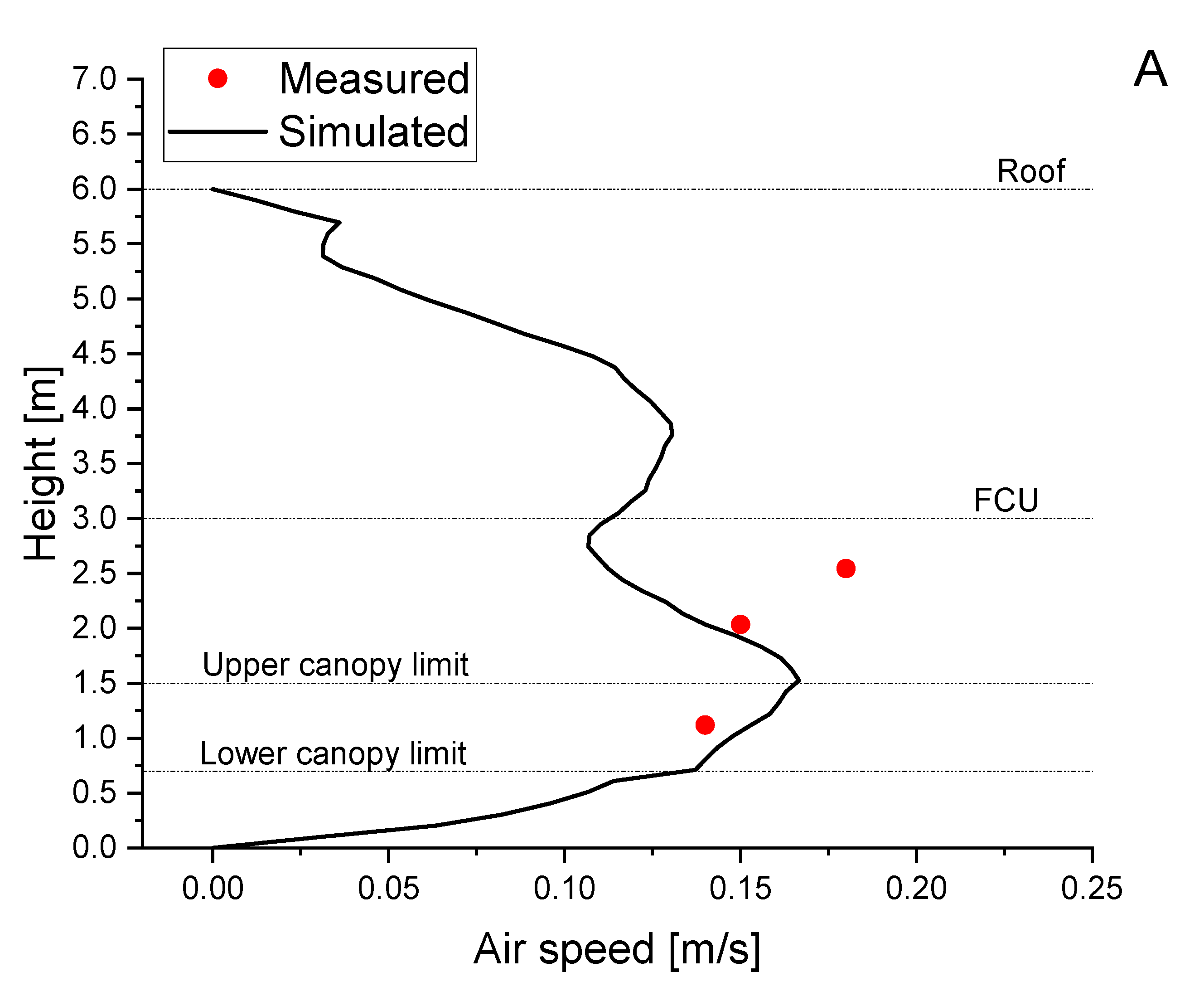
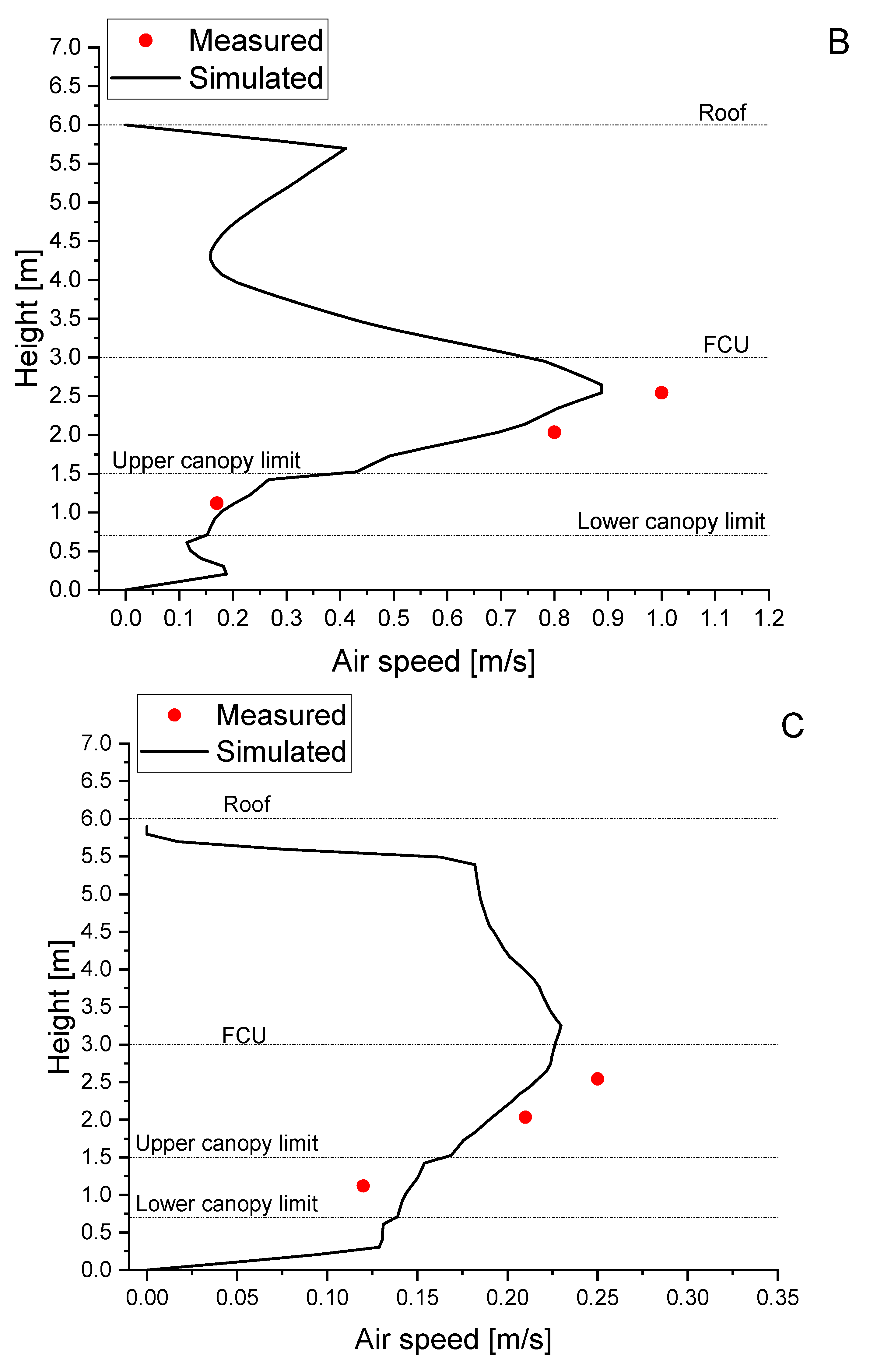
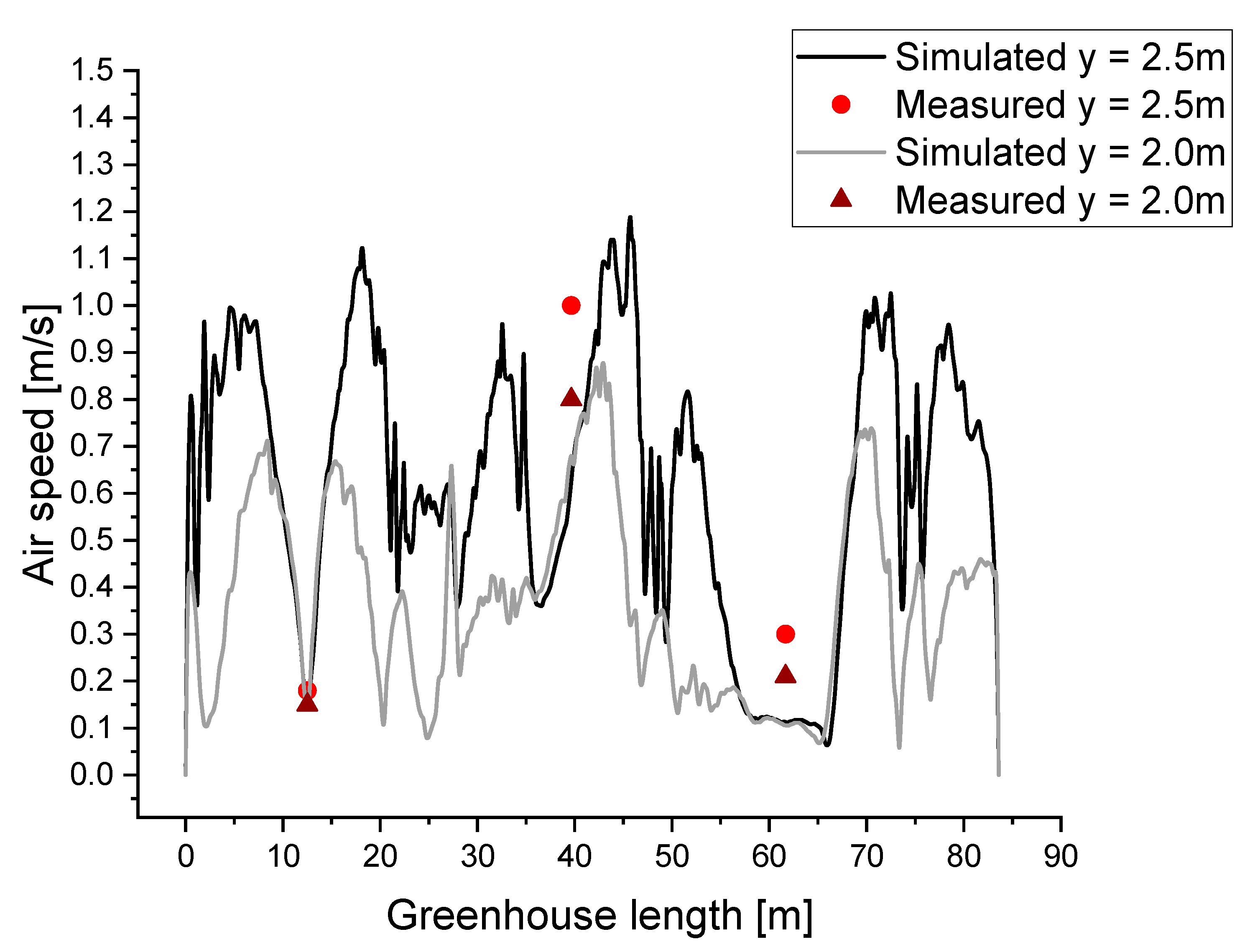
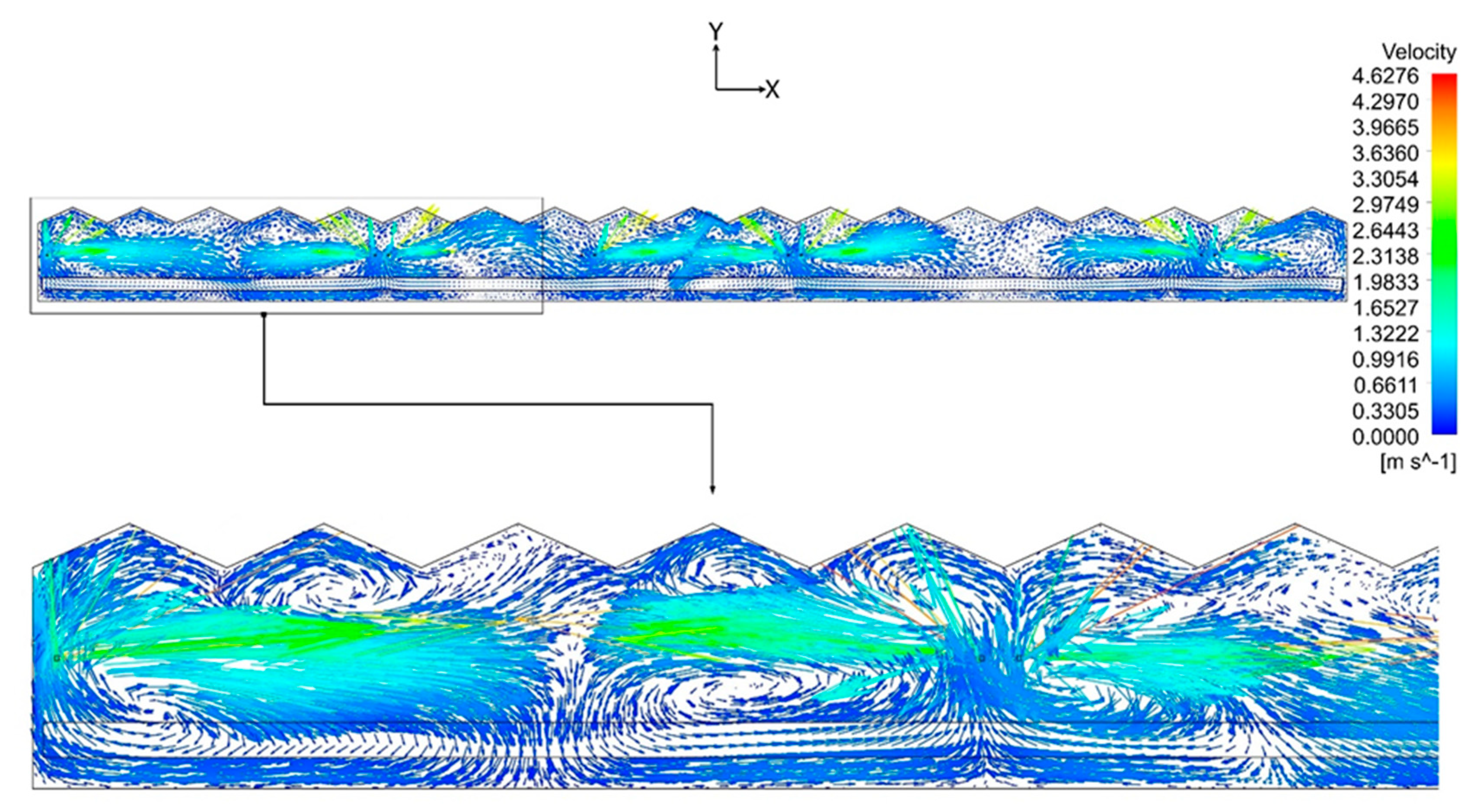

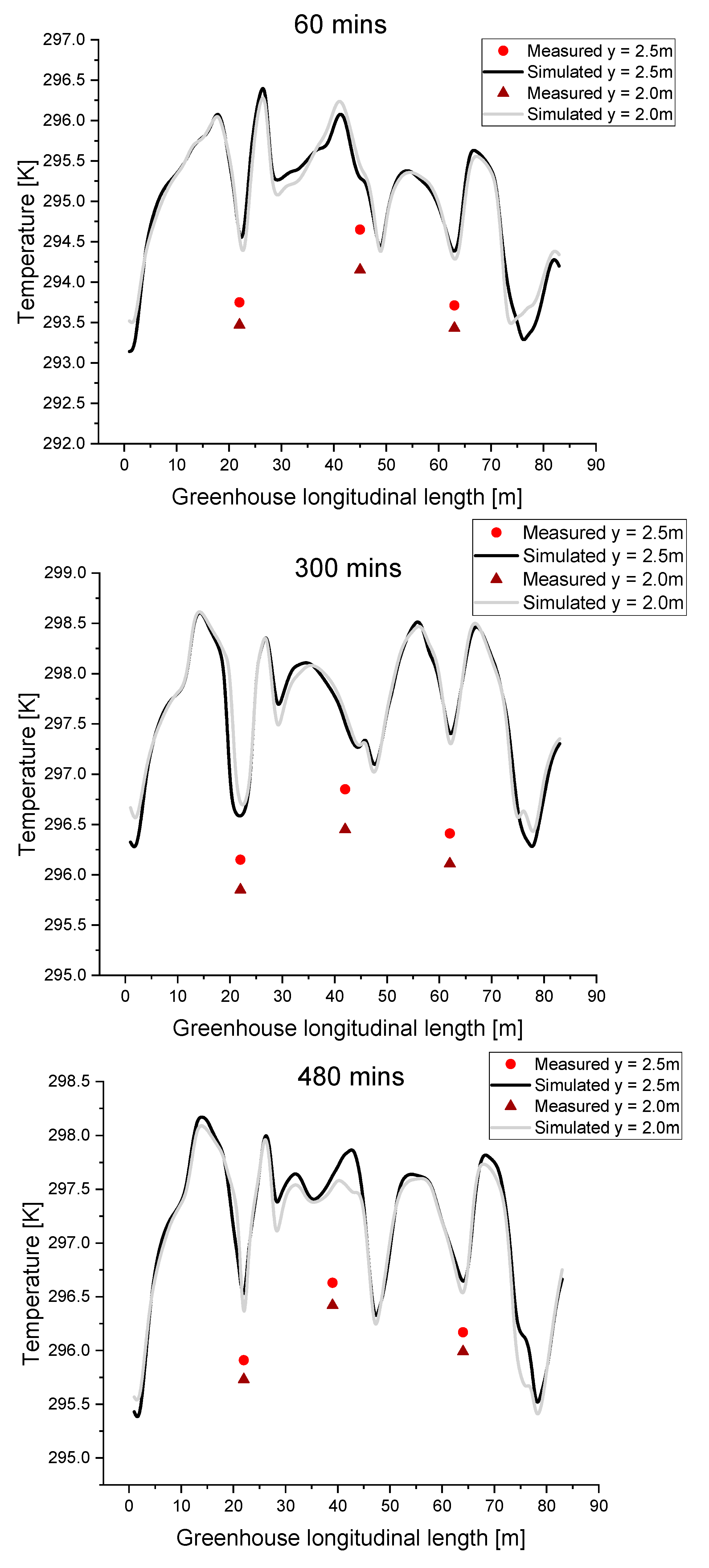
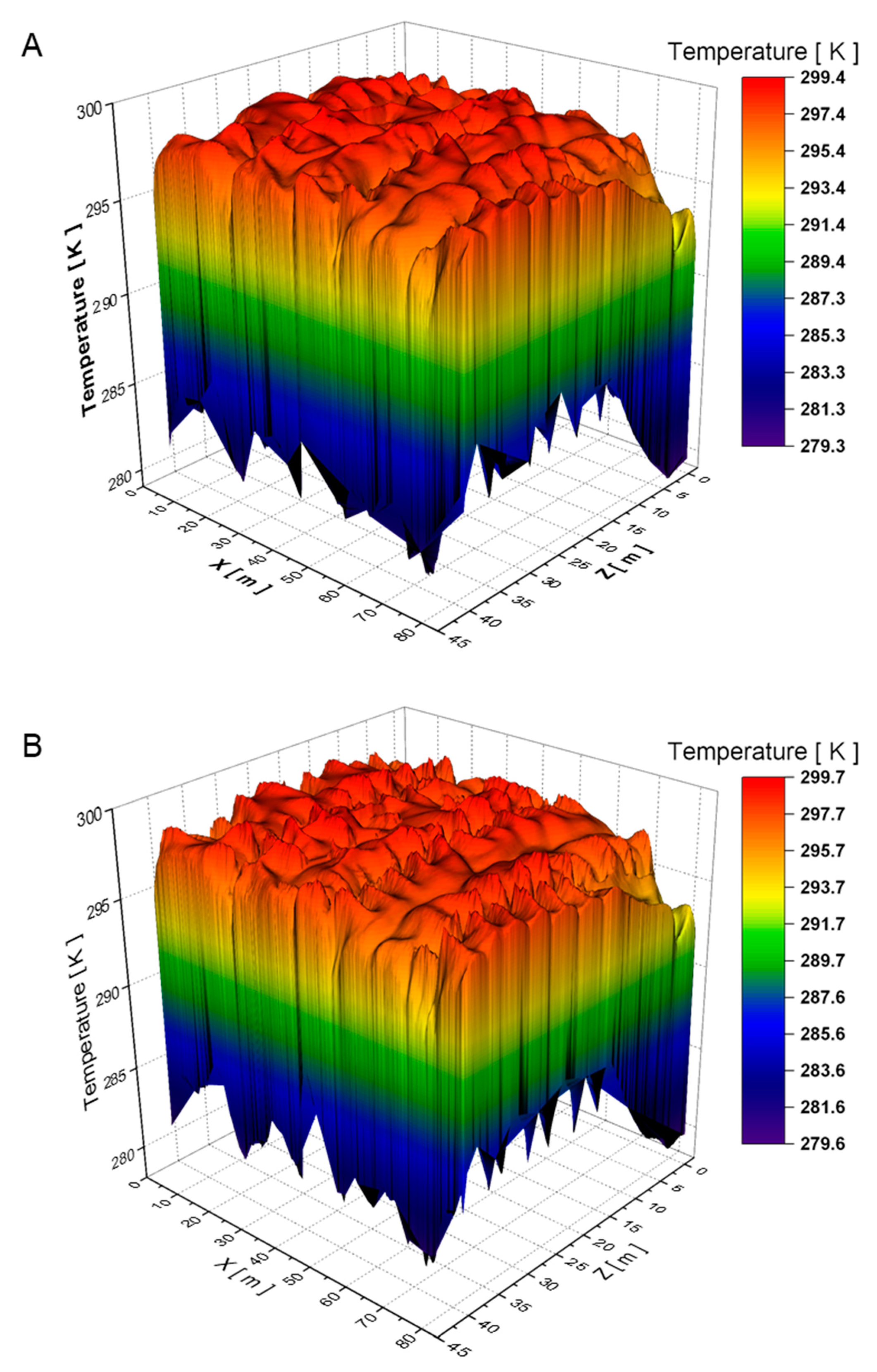
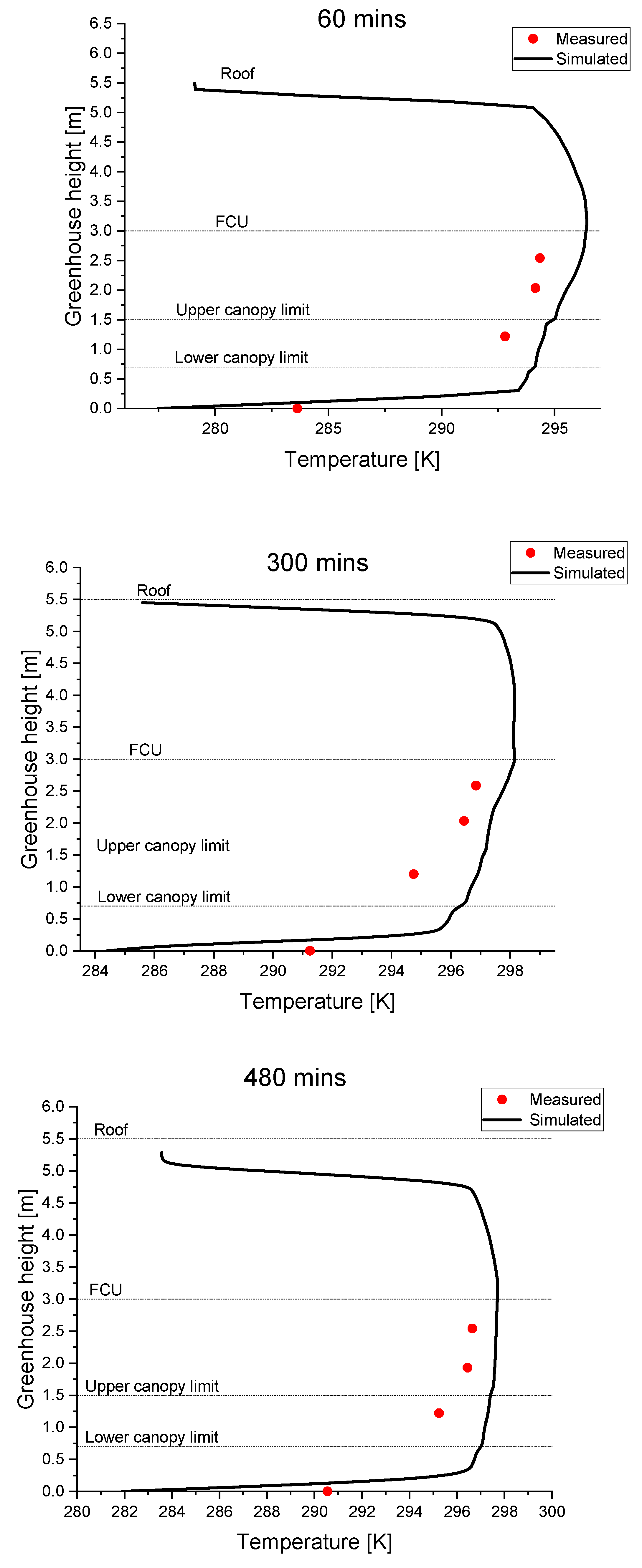
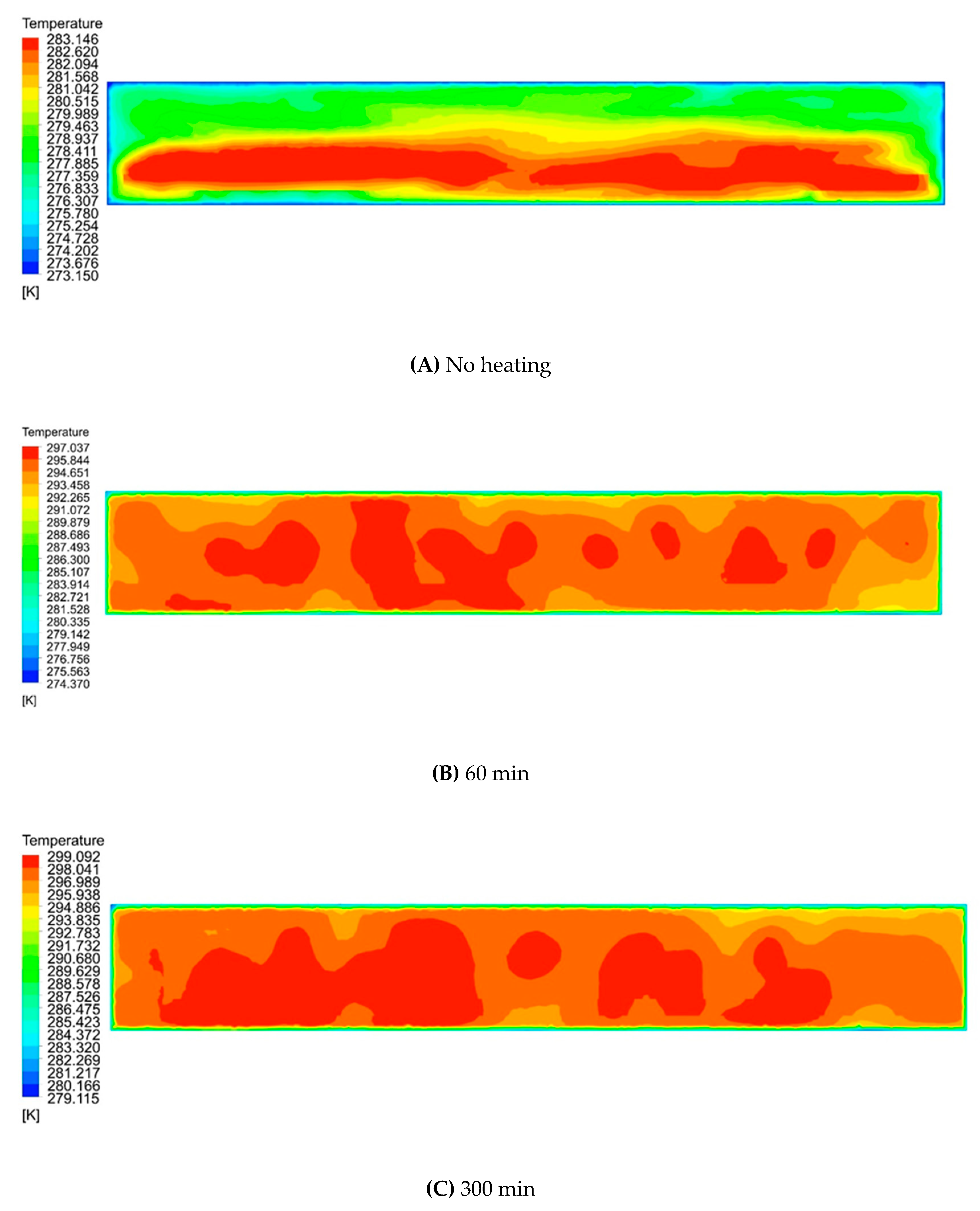

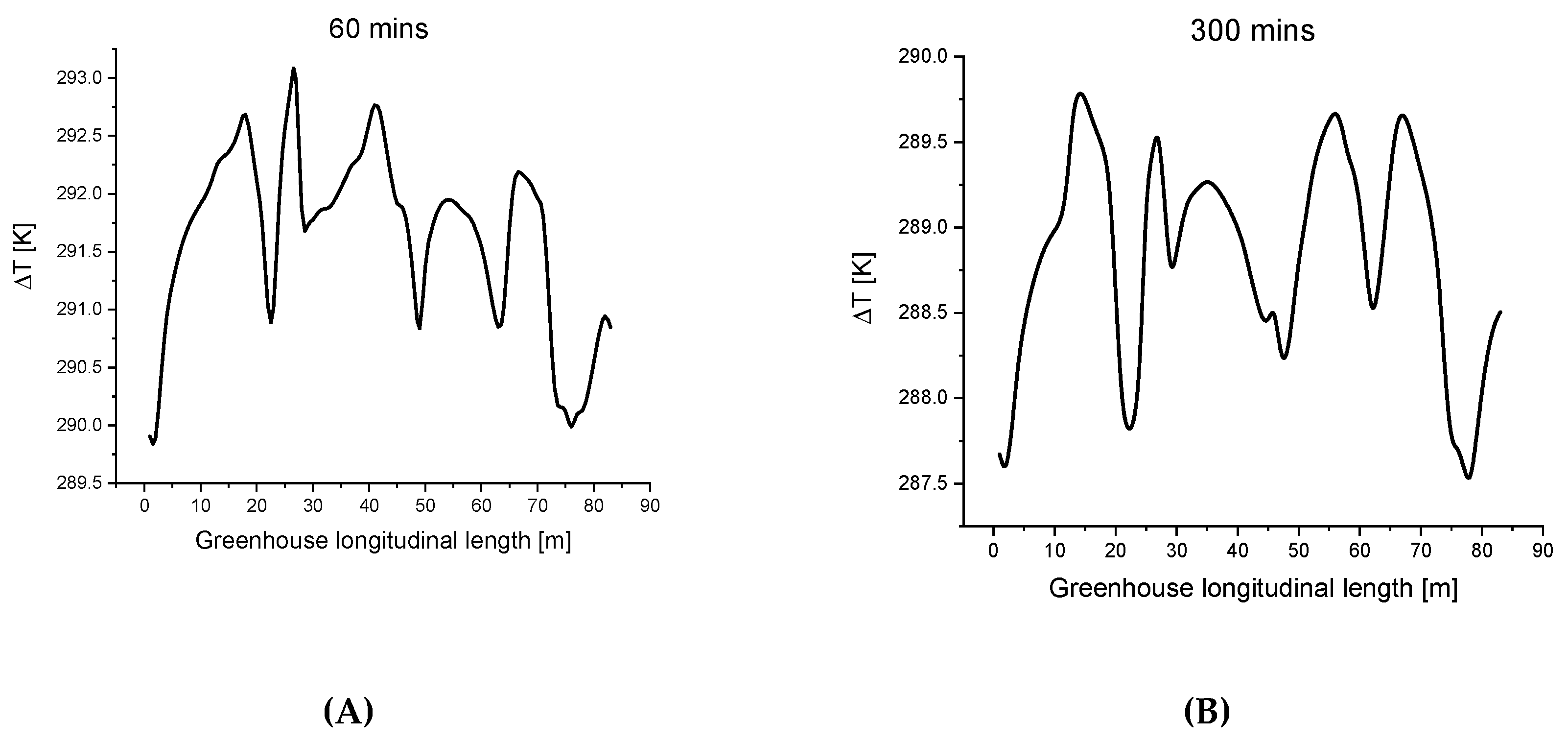
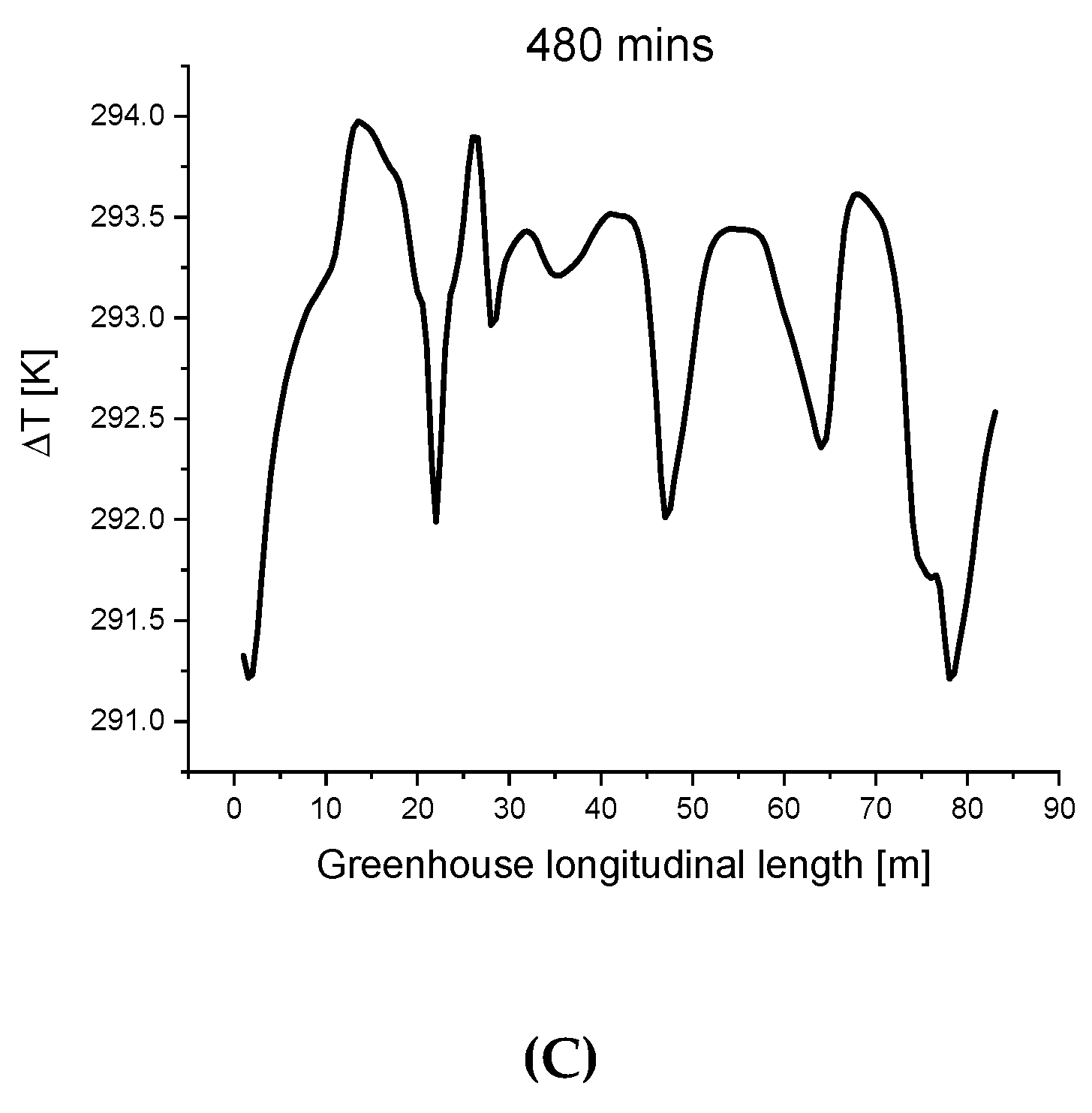


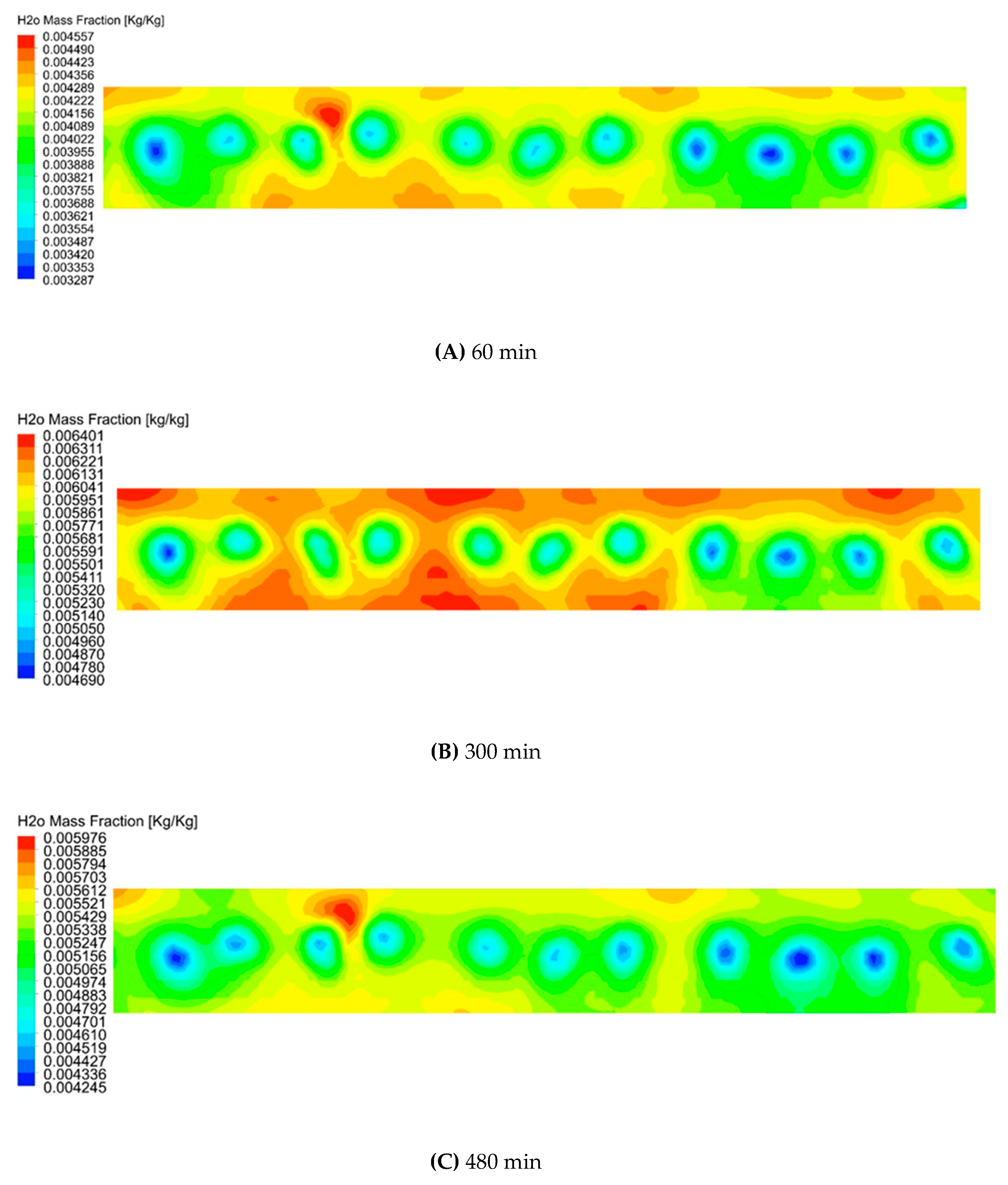


| CFD Component | Method/Parameter/Setting |
|---|---|
| Solver settings | 3-D transient simulation |
| Scheme | SIMPLE* scheme, pressure-velocity coupling |
| Gradient discrete scheme | Green–Gauss node based 1 |
| Pressure discrete scheme | Body force weighted method 2 |
| Momentum, k and , water vapor, energy, and discrete ordinates scheme | Second-order upwind scheme |
| Transient formulation | Bounded second-order implicit 3 |
| Relaxation factors | |
| Pressure | 0.3 |
| Density | 1 |
| Body force | 0.9 |
| Momentum | 0.7 |
| k and | 0.7 |
| Turbulent viscosity | 0.8 |
| Water vapor | 0.7 |
| Energy | 0.8 |
| DO | 0.8 |
| Models | |
| Radiation | Discrete ordinates model Theta and phi divisions: 3 Theta and phi pixels: 3 Energy iterations per radiation iteration: 10 |
| Species | Mixture of dry air and water vapor |
| Property | Glass | Water Vapor | Air | Concrete Floor |
|---|---|---|---|---|
| Density | 2500 | 0.5542 | 1.225 | 2300 |
| Specific heat | 840 | f(T)* | 1006.43 | 2300 |
| Thermal conductivity | 1.2 | 0.0261 | 0.0242 | 1.4 |
| Absorption coefficient | - | 0.54 | 0.19 | 0.92 |
| Scattering coefficient | - | - | - | 0.12 |
| Refractive Index | 1.52 | 1 | 1 | 1.92 |
| Emissivity | 0.9 | - | 0.9 | 0.5 |
| Air Temperature [°C] | Absolute Humidity [g/kg] | |||||
|---|---|---|---|---|---|---|
| Time [mins] | MAE* | RMSE* | r2 | MAE | RMSE | r2 |
| 60 [9~10] | 2.87 | 2.88 | 0.915 | 2.43 | 2.44 | 0.921 |
| 120 [10~11] | 2.01 | 2.03 | 0.896 | 2.19 | 2.20 | 0.896 |
| 180 [11~12] | 1.45 | 1.49 | 0.923 | 2.15 | 2.17 | 0.903 |
| 240 [12~13] | 1.11 | 1.16 | 0.926 | 2.14 | 2.18 | 0.914 |
| 300 [13~14] | 0.99 | 1.10 | 0.947 | 2.01 | 2.02 | 0.906 |
| 360 [14~15] | 1.25 | 1.28 | 0.906 | 2.03 | 2.04 | 0.893 |
| 420 [15~16] | 1.65 | 1.67 | 0.927 | 2.05 | 2.07 | 0.920 |
| 480 [16~17] | 1.67 | 1.69 | 0.933 | 2.06 | 2.09 | 0.912 |
| Air Velocity | Air Temperature | Absolute Humidity | |
|---|---|---|---|
| F | 1.1161 | 1.0871 | 1.1684 |
| p-value | 0.4201 | 0.4037 | 0.2695 |
Publisher’s Note: MDPI stays neutral with regard to jurisdictional claims in published maps and institutional affiliations. |
© 2020 by the authors. Licensee MDPI, Basel, Switzerland. This article is an open access article distributed under the terms and conditions of the Creative Commons Attribution (CC BY) license (http://creativecommons.org/licenses/by/4.0/).
Share and Cite
Odhiambo, M.R.O.; Abbas, A.; Wang, X.; Elahi, E. Thermo-Environmental Assessment of a Heated Venlo-Type Greenhouse in the Yangtze River Delta Region. Sustainability 2020, 12, 10412. https://doi.org/10.3390/su122410412
Odhiambo MRO, Abbas A, Wang X, Elahi E. Thermo-Environmental Assessment of a Heated Venlo-Type Greenhouse in the Yangtze River Delta Region. Sustainability. 2020; 12(24):10412. https://doi.org/10.3390/su122410412
Chicago/Turabian StyleOdhiambo, Morice R. O., Adnan Abbas, Xiaochan Wang, and Ehsan Elahi. 2020. "Thermo-Environmental Assessment of a Heated Venlo-Type Greenhouse in the Yangtze River Delta Region" Sustainability 12, no. 24: 10412. https://doi.org/10.3390/su122410412
APA StyleOdhiambo, M. R. O., Abbas, A., Wang, X., & Elahi, E. (2020). Thermo-Environmental Assessment of a Heated Venlo-Type Greenhouse in the Yangtze River Delta Region. Sustainability, 12(24), 10412. https://doi.org/10.3390/su122410412







